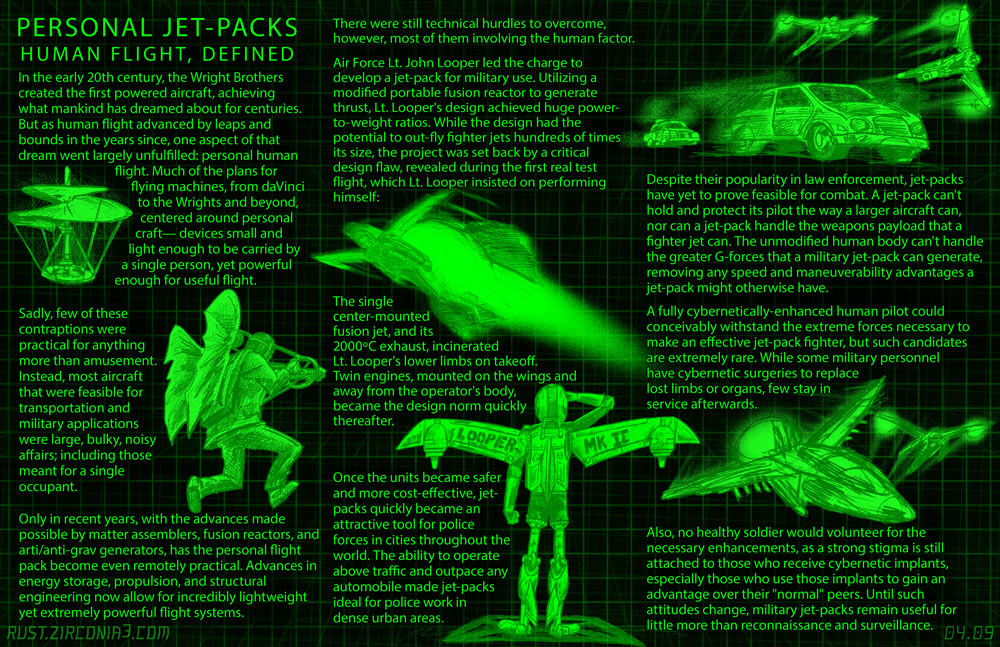 (Yes, that 2nd pic is from a Monty Python bit: the intro to the episode with the "Spanish Inquisition" sketches, which are quite possibly my favorite Python bits (particularly Terry Gilliam and "THE COMFY CHAIR?!?").
(Yes, that 2nd pic is from a Monty Python bit: the intro to the episode with the "Spanish Inquisition" sketches, which are quite possibly my favorite Python bits (particularly Terry Gilliam and "THE COMFY CHAIR?!?").
Update: XKCD sums up the middle column quite succinctly.
As always, here's all that type below, so you don't kill your eyes trying to read it above.
PERSONAL JET-PACKS
HUMAN FLIGHT, DEFINED
In the early 20th century, the Wright Brothers created the first powered aircraft, achieving what mankind has dreamed about for centuries. But as human flight advanced by leaps and bounds in the years since, one aspect of that dream went largely unfulfilled: personal human flight. Much of the plans for flying machines, from daVinci to the Wrights and beyond, centered around personal craft-- devices small and light enough to be carried by a single person, yet powerful enough for useful flight.
Sadly, few of these contraptions were practical for anything more than amusement. Instead, most aircraft that were feasible for transportation and military applications were large, bulky, noisy affairs; including those meant for a single occupant.
Only in recent years, with the advances made possible by matter assemblers, fusion reactors, and arti/anti-grav generators, has the personal flight pack become even remotely practical. Advances in energy storage, propulsion, and structural engineering now allow for incredibly lightweight yet extremely powerful flight systems.
There were still technical hurdles to overcome, however, most of them involving the human factor.
Air Force Lt. John Looper led the charge to develop a jet-pack for military use. Utilizing a modified portable fusion reactor to generate thrust, Lt. Looper's design achieved huge power-to-weight ratios. While the design had the potential to out-fly fighter jets hundreds of times its size, the project was set back by a critical design flaw, revealed during the first real test flight, which Lt. Looper insisted on performing himself:
The single center-mounted fusion jet, and its 2000°C exhaust, incinerated Lt. Looper's lower limbs on takeoff. Twin engines, mounted on the wings and away from the operator's body, became the design norm quickly thereafter.
Once the units became safer and more cost-effective, jet-packs quickly became an attractive tool for police forces in cities throughout the world. The ability to operate above traffic and outpace any automobile made jet- packs ideal for police work in dense urban areas.
Despite their popularity in law enforcement, jet-packs have yet to prove feasible for combat. A jet-pack can't hold and protect its pilot the way a larger aircraft can, nor can a jet-pack handle the weapons payload that a fighter jet can. The unmodified human body can't handle the greater G-forces that a military jet-pack can generate, removing any speed and maneuverability advantages a jet-pack might otherwise have.
A fully cybernetically-enhanced human pilot could conceivably withstand the extreme forces necessary to make an effective jet-pack fighter, but such candidates are extremely rare. While some military personnel have cybernetic surgeries to replace lost limbs or organs, few stay in service afterwards.
Also, no healthy soldier would volunteer for the necessary enhancements, as a strong stigma is still attached to those who receive cybernetic implants, especially those who use those implants to gain an advantage over their "normal" peers. Until such attitudes change, military jet- packs remain useful for little more than reconnaissance and surveillance.

